Yamnaya culture
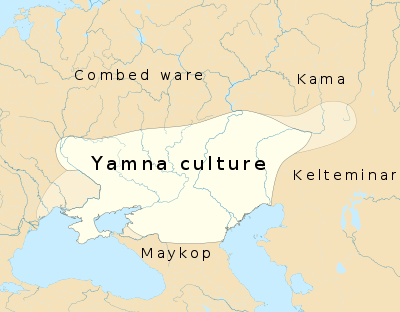 | |
| Alternative names |
|
|---|---|
| Geographical range | Europe |
| Period | Bronze Age |
| Dates | c. 3300–2600 BC |
| Preceded by | Sredny Stog culture, Khvalynsk culture, Dnieper–Donets culture |
| Followed by |
west: Catacomb culture; east: Poltavka culture, Srubna culture; north: Corded Ware culture (derived from Yamna culture)[1] |

| Part of a series on |
| Indo-European topics |
|---|
 |
|
|
Origins |
|
Archaeology Pontic Steppe Caucasus East Asia Eastern Europe Northern Europe Pontic Steppe Northern/Eastern Steppe Europe
South Asia Steppe Europe Caucasus India |
|
Peoples and societies Indo-Aryans Iranians Europe East Asia Europe Indo-Aryan Iranian |
|
|
The Yamna culture (Ukrainian: Ямна культура, lit. 'pit culture') or Yamnaya culture (Russian: Ямная культура), sometimes rendered in English as Pit Grave culture or Ochre Grave culture, was a late Copper Age to early Bronze Age archaeological culture of the region between the Southern Bug, Dniester and Ural rivers (the Pontic steppe), dating to 3300–2600 BC.[2] Its name refers to its characteristic burial tradition: kurgans containing a simple pit chamber.
The people of the Yamnaya culture were the likely result of admixture between eastern European hunter-gatherers (via whom they also descend from the Mal'ta–Buret' culture or other, closely related people) and a Near Eastern people,[3] with some research identifying the latter as hunter-gatherers from the Caucasus[4] or a similar people also related to Chalcolithic people from what is now Iran.[5] Their material culture is very similar to the Afanasevo culture, their contemporaries in the Altai Mountains; furthermore, genetic tests have confirmed that the two groups are genetically indistinguishable.[3]
They are also closely connected to later, Final Neolithic cultures which spread throughout Europe and Central Asia, especially the Corded Ware people, but also the Bell Beaker culture as well as the peoples of the Sintashta, Andronovo, and Srubna cultures. In these groups, several aspects of the Yamna culture (e.g., horse-riding, burial styles, and to some extent the pastoralist economy) are present. Genetic studies have also indicated that these populations derived large parts of their ancestry from the steppes.[3][6][7][8]
The Yamna culture is identified with the late Proto-Indo-Europeans, and is the strongest candidate for the urheimat (homeland) of the Proto-Indo-European language.
Origins
Culture
The Yamna culture originated in the Don–Volga area, and is dated 3300–2600 BC.[9][10] It was preceded by the middle Volga-based Khvalynsk culture and the Don-based Repin culture (ca. 3950–3300 BC),[11] and late pottery from these two cultures can barely be distinguished from early Yamna pottery.[12]
According to Anthony (2007), the early Yamnaya horizon spread quickly across the Pontic–Caspian steppes between ca. 4000 and 3200 BC.[13] According to Anthony, "the spread of the Yamnaya horizon was the material expression of the spread of late Proto-Indo-European across the Pontic–Caspian steppes."[14] Anthony further notes that "the Yamnaya horizon is the visible archaeological expression of a social adjustment to high mobility – the invention of the political infrastructure to manage larger herds from mobile homes based in the steppes."[15] According to Pavel Dolukhanov the emergence of the Pit-Grave culture represents a social development of various local Bronze Age cultures, representing "an expression of social stratification and the emergence of chiefdom-type nomadic social structures", which in turn intensified inter-group contacts between essentially heterogeneous social groups.[16]
In its western range, it was succeeded by the Catacomb culture (2800–2200 BC); in the east, by the Poltavka culture (2700–2100 BC) at the middle Volga. These two cultures were followed by the Srubna culture (18th–12th century BC).
People
According to Jones et al. (2015) and Haak et al. (2015), autosomic tests indicate that the Yamnaya people were the result of admixture between two different hunter-gatherer populations: distinctive "Eastern European hunter-gatherers" with high affinity to the Mal'ta–Buret' culture or other, closely related people from Siberia[3] and a population of "Caucasus hunter-gatherers" who probably arrived from somewhere in the Near East, probably the Caucasus.[4][web 1] Each of those two populations contributed about half the Yamnaya DNA.[6][web 1] According to co-author Andrea Manica of the University of Cambridge:
The question of where the Yamnaya come from has been something of a mystery up to now [...] we can now answer that, as we've found that their genetic make-up is a mix of Eastern European hunter-gatherers and a population from this pocket of Caucasus hunter-gatherers who weathered much of the last Ice Age in apparent isolation.[web 1]
Several genetic studies performed since 2015 have given support to the Kurgan theory of Marija Gimbutas regarding the Indo-European Urheimat – that Indo-European languages spread throughout Europe from the Eurasian steppes and that the Yamna culture were Proto-Indo-Europeans. According to those studies, haplogroups R1b and R1a, now the most common in Europe (with R1a also being common in South Asia), would have expanded from the Pontic–Caspian steppes, along with the Indo-European languages. They also detected an autosomal component present in modern Europeans which was not present in Neolithic Europeans, which would have been introduced with paternal lineages R1b and R1a, as well as Indo-European languages in the Bronze Age.[17][18][19]
Eastern European hunter-gatherers
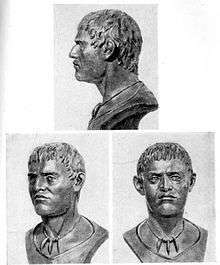
According to Haak et al. (2015), "Eastern European hunter-gatherers" who inhabited today's Russia were a distinctive population of hunter-gatherers with high affinity to a ~24,000-year-old Siberian from Mal'ta–Buret' culture,which physiologically resembles East Asia[20] and other, closely related people from Siberia.[3][web 1] Remains of the "Eastern European hunter-gatherers" have been found in Mesolithic or early Neolithic sites in Karelia and Samara Oblast, Russia, and put under analysis. Three such hunter-gathering individuals of the male sex have had their DNA results published. Each was found to belong to a different Y-DNA haplogroup: R1a, R1b, and J.[6] R1b is also the most common Y-DNA haplogroup found among both the Yamnaya and modern-day Western Europeans.[3][7]
Near East population
The Near East population were most likely hunter-gatherers from the Caucasus (CHG),[4] in this case Iran Chalcolithic related people with a CHG-component, who partially descended from the early neolithic Zagros Farmers.[5]
Jones et al. (2015) analyzed genomes from males from western Georgia, in the Caucasus, from the Late Upper Palaeolithic (13,300 years old) and the Mesolithic (9,700 years old). These two males carried Y-DNA haplogroup: J* and J2a. The researchers found that these Caucasus hunters were probably the source of the farmer-like DNA in the Yamnaya, as the Caucasians were distantly related to the Middle Eastern people who introduced farming in Europe.[web 1] Their genomes showed that a continued mixture of the Caucasians with Middle Eastern took place up to 25,000 years ago, when the coldest period in the last Ice Age started.[web 1]
Lazaridis et al. (2016) proposes a different people, likely from Iran, as the source for the Middle Eastern ancestry of the Yamna people, finding that "a population related to the people of the Iran Chalcolithic contributed ~43% of the ancestry of early Bronze Age populations of the steppe."[5] That study asserts that these Iranian Chalcolithic people were a mixture of "the Neolithic people of western Iran, the Levant, and Caucasus Hunter Gatherers."[5][note 1] However, a different analysis, carried out by Gallego-Llorente et al. (2016), concludes that Iranian populations are not a likelier source of the 'southern' component in the Yamnaya than Caucasus hunter-gatherers.[21]
Characteristic
Proto-Indo-European
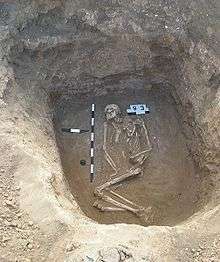
The Yamna culture is identified with the late Proto-Indo-Europeans (PIE) in the Kurgan hypothesis of Marija Gimbutas. It is the strongest candidate for the Urheimat (homeland) of the Proto-Indo-European language, along with the preceding Sredny Stog culture, now that archaeological evidence of the culture and its migrations has been closely tied to the evidence from linguistics[22] and genetics.[3][23] Significantly, animal grave offerings were made (cattle, sheep, goats and horse), a feature associated with Proto-Indo-Europeans.[24] The culture was predominantly nomadic, with some agriculture practiced near rivers and a few hillforts.[25] Characteristic for the culture are the inhumations in pit graves under kurgans (tumuli). The dead bodies were placed in a supine position with bent knees and covered in ochre. Multiple graves have been found in these kurgans, often as later insertions. The earliest remains in Ukraine of a wheeled cart were found in the "Storozhova mohyla" kurgan (Dnipro, Ukraine, excavated by A. I. Trenozhkin) associated with the Yamna culture.
Physical characteristics
The genetic basis of a number of physical features of the Yamnaya people were ascertained by the ancient DNA study conducted by Haak et al. (2015), Wilde et al. (2014), Mathieson et al. (2015): they were genetically tall (phenotypic height is determined by both genetics and environmental factors), overwhelmingly dark-eyed (brown), dark-haired and had a skin colour that was moderately light, though somewhat darker than that of the average modern European.[26][6] Despite their pastoral lifestyle, there was little evidence of lactase persistence.[27]
Yamna-related migrations
Western Europe
Haak et al. (2015) conducted a genome-wide study of 69 ancient skeletons from Europe and Russia. They concluded that Yamnaya autosomal characteristics are very close to the Corded Ware culture people, with an estimated a 73% ancestral contribution from the Yamnaya DNA in the DNA of Corded Ware skeletons from Germany. The same study estimated a 38.8–53.5% ancestral contribution of the Yamnaya in the DNA of modern Western, Central & Northern Europeans, and an 18.5–32.6% contribution in modern Southern Europeans; this contribution is found to a lesser extent in Sardinians (2.4%–7.1%) and Sicilians (5.9–11.6%).[28][23][web 2] Haak et al. also note that their results "suggest" that haplogroups R1b and R1a "spread into Europe from the East after 3,000 BC."[29] Studies which analysed ancient human remains in Ireland and Portugal support that thesis, that R1b was introduced in these places along with autosomal DNA from the Eastern European steppes.[30][31]
Autosomal tests also indicate that the Yamnaya are the most likely vector for "Ancient North Eurasian" admixture into Europe.[3] "Ancient North Eurasian" is the name given in literature to a genetic component that represents descent from the people of the Mal'ta–Buret' culture[3] or a population closely related to them. That genetic component is visible in tests of the Yamna people[3] as well as modern-day Europeans, but not of Europeans predating the Bronze Age.[32]
Eastern Europe and Finland
In the Baltic, Jones et al. (2017) found that the Neolithic transition – the passage from a hunter-gatherer economy to a farming-based economy – coincided with the arrival en masse of individuals with Yamnaya-like ancestry. This is different from what happened in Western and Southern Europe, where the Neolithic transition was caused by a population which came from the Near East, with Pontic steppe ancestry only being detected from the late Neolithic onward.[33]
Per Haak et al. (2015), the Yamnaya contribution in the modern populations of Eastern Europe ranges from 46.8–64.9% among Russians to 42.8% in Ukrainians. Finland has one of the highest Yamnaya contributions in all of Europe (50.4–67.8%).[34]
Central and South Asia
Lazaridis et al. (2016) "While the Early/Middle Bronze Age ‘Yamnaya’-related group (Steppe_EMBA) is a good genetic match (together with Neolithic Iran) for ANI (Ancestral North Indians), the later Middle/Late Bronze Age steppe population (Steppe_MLBA) is not."[35][note 2] Lazaridis et al. (2016) "The demographic impact of steppe related populations on South Asia was substantial, as the Mala, a south Indian population with minimal ANI along the ‘Indian Cline’ of such ancestry is inferred to have ~18% steppe-related ancestry, while the Kalash of Pakistan are inferred to have ~50%, similar to present-day northern Europeans."[35] Lazaridis et al. (2016) study estimated 50%–30% steppe related admixture in Northern South Asians and 20% to 6% in Southern South Asians.[36][note 3]
Lazaridis et al. (2016) further notes that "A useful direction of future research is a more comprehensive sampling of ancient DNA from steppe populations, as well as populations of central Asia (east of Iran and south of the steppe), which may reveal more proximate sources of the ANI than the ones considered here, and of South Asia to determine the trajectory of population change in the area directly."[37]
According to Unterländer et al. (2017), Iron Age Scythians from the southern Ural region, East Kazakhstan and Tuva can best be described as a mixture of Yamnaya-related ancestry and an East Asian component, the latter occurring only at trace levels – if at all – among earlier steppe inhabitants.[38]
Artifacts
- From the Hermitage Museum collections
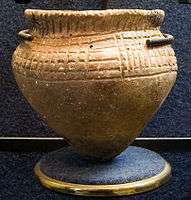 Corded ware pot
Corded ware pot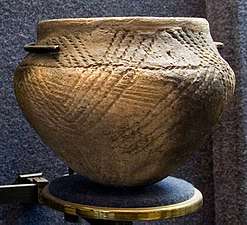 Corded ware pot
Corded ware pot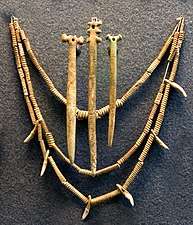
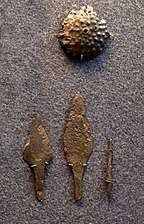
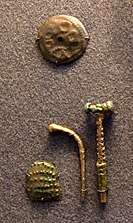

See also
| Wikimedia Commons has media related to Yamna culture. |
Notes
- ↑ See also:
* eurogenes.blogspot, The genetic structure of the world's first farmers (Lazaridis et al. preprint)
* anthrogenica.com, Lazaridis et al: The genetic structure of the world's first farmers (pre-print) - ↑ (Steppe_EMBA) refers to Yamnaya-related group, which is good genetic match for ANI. While (Steppe_MLBA) Sintashta/Andronovo-related group were not.
- ↑ Lazaridis et al. (2016) Supplementary Information, Table S9.1: "Kalash – 50.2%, Tiwari Brahmins – 44.1%, Gujarati (four samples) – 46.1% to 27.5%, Pathan – 44.6%, Burusho – 42.5%, Sindhi – 37.7%, Punjabi – 32.6%, Balochi – 32.4%, Brahui – 30.2%, Lodhi – 29.3%, Bengali – 24.6%, Vishwabhramin – 20.4%, Makrani – 19.2%, Mala – 18.4%, Kusunda – 8.9%, Kharia – 6.5%.."
References
- ↑ Allentoft 2015.
- ↑ Morgunova & Khokhlova 2013.
- 1 2 3 4 5 6 7 8 9 10 Haak 2015.
- 1 2 3 Jones 2015.
- 1 2 3 4 Lazaridis 2016, p. 8.
- 1 2 3 4 Mathieson 2015.
- 1 2 Morten E. Allentoft; et al. (2015). "Population genomics of Bronze Age Eurasia". Nature. 522: 167–172. Bibcode:2015Natur.522..167A. doi:10.1038/nature14507.
- ↑ http://www.sciencemag.org/news/2015/06/nomadic-herders-left-strong-genetic-mark-europeans-and-asians
- ↑ Morgunova, Nina (2013). "Chronology and Periodization of the Pit-Grave Culture in the Area Between the Volga and Ural Rivers Based on 14C Dating and Paleopedological Research". Radiocarbon. University of Arizona. 55 (2–3).
- ↑ Anthony 2007, p. 300.
- ↑ Anthony 2007, p. 275.
- ↑ Anthony 2007, p. 274–277, 317–320.
- ↑ Anthony 2007, p. 321.
- ↑ Anthony 2007, pp. 301–302.
- ↑ Anthony 2007, p. 303.
- ↑ Dolukhanov 1996, p. 94.
- ↑ Massive migration from the steppe is a source for Indo-European languages in Europe, Haak et al, 2015
- ↑ Population genomics of Bronze Age Eurasia, Allentoft et al, 2015
- ↑ Eight thousand years of natural selection in Europe, Mathieson et al, 2015
- ↑ Dolukhanov, Pavel M. (2003). "Archaeology and Languages in Prehistoric Northern Eurasia" (PDF). Japan Review. 15: 175–86.
- ↑ Gallego-Llorente, M.; et al. (2016). "The genetics of an early Neolithic pastoralist from the Zagros, Iran". Scientific Reports. Bibcode:2016NatSR...631326G. doi:10.1038/srep31326.
- ↑ Anthony 2007.
- 1 2 Zimmer 2015.
- ↑ Fortson 2004, p. 43.
- ↑ Mallory 1997.
- ↑ Sandra Wilde (2014). "Direct evidence for positive selection of skin, hair, and eye pigmentation in Europeans during the last 5,000 y". PNAS. 111: 4832–4837. Bibcode:2014PNAS..111.4832W. doi:10.1073/pnas.1316513111. PMC 3977302.
- ↑ Haak, 2015
- ↑ Haak 2015, pp. 121–124.
- ↑ Haak 2015, p. 5.
- ↑ Lara M. Cassidy; et al. (2016). "Neolithic and Bronze Age migration to Ireland and establishment of the insular Atlantic genome". PNAS. 113 (2): 368–373. Bibcode:2016PNAS..113..368C. doi:10.1073/pnas.1518445113.
- ↑ Rui Martiniano; et al. (2017). "The population genomics of archaeological transition in west Iberia: Investigation of ancient substructure using imputation and haplotype-based methods". PLoS Genet. 13 (7). doi:10.1371/journal.pgen.1006852.
- ↑ Lazaridis 2014.
- ↑ Eppie R. Jones; et al. (2017). "The Neolithic Transition in the Baltic Was Not Driven by Admixture with Early European Farmers". Current Biology. 27 (4): 576–582. doi:10.1016/j.cub.2016.12.060.
- ↑ Haak 2015, pp. 121–122.
- 1 2 Lazaridis et al. (2016), pp. 123.
- ↑ Lazaridis, Iosif; Nadel, Dani; Rollefson, Gary; et al. (16 June 2016). "Supplementary Information : The genetic structure of the world's first farmers" (PDF). 536: 419–424. Bibcode:2016Natur.536..419L. doi:10.1038/nature19310.
- ↑ Lazaridis, Iosif; Nadel, Dani; Rollefson, Gary; Merrett, Deborah C.; Rohland, Nadin; Mallick, Swapan; Fernandes, Daniel; Novak, Mario; Gamarra, Beatriz; Sirak, Kendra; Connell, Sarah; Stewardson, Kristin; Harney, Eadaoin; Fu, Qiaomei; Gonzalez-Fortes, Gloria; Alpaslan Roodenberg, Songül; Lengyel, Gyorgy; Bocquentin, Fanny; Gasparian, Boris; Monge, Janet M.; Gregg, Michael; Eshed, Vered; Mizrahi, Ahuva-Sivan; Meiklejohn, Christopher; Gerritsen, Fokke; Bejenaru, Luminita; Blueher, Matthias; Campbell, Archie; Cavalleri, Gianpero; Comas, David; Froguel, Philippe; Gilbert, Edmund; Kerr, Shona M.; Kovacs, Peter; Krause, Johannes; McGettigan, Darren; Merrigan, Michael; Merriwether, D. Andrew; O'Reilly, Seamus; Richards, Martin B.; Semino, Ornella; Shamoon-Pour, Michel; Stefanescu, Gheorghe; Stumvoll, Michael; Tonjes, Anke; Torroni, Antonio; Wilson, James F.; Yengo, Loic; Hovhannisyan, Nelli A.; Patterson, Nick; Pinhasi, Ron; Reich, David (2016). "The genetic structure of the world's first farmers". bioRxiv 059311.
- ↑ Unterländer, Martina; et al. (2017). "Ancestry and demography and descendants of Iron Age nomads of the Eurasian Steppe". Nature Communications. 8: 14615. Bibcode:2017NatCo...814615U. doi:10.1038/ncomms14615. ISSN 2041-1723. Retrieved 2017-07-09.
Sources
Printed sources
- Anthony, David W. (2007), The Horse, The Wheel and Language: How Bronze-Age Riders from the Eurasian Steppes Shaped the Modern World
- Dolukhanov, Pavel M. (1996), The Early Slavs: Eastern Europe from the Initial Settlement to the Kievan Rus, New York: Longman, ISBN 0-582-23627-4
- Fortson, Benjamin W. (2004), Indo-European Language and Culture: An Introduction, Blackwell Publishing
- Haak, W.; Lazaridis, I.; Patterson, N.; Rohland, N.; Mallick, S.; Llamas, B.; Brandt, G.; Nordenfelt, S.; Harney, E.; Stewardson, K.; Fu, Q.; Mittnik, A.; Bánffy, E.; Economou, C.; Francken, M.; Friederich, S.; Pena, R. G.; Hallgren, F.; Khartanovich, V.; Khokhlov, A.; Kunst, M.; Kuznetsov, P.; Meller, H.; Mochalov, O.; Moiseyev, V.; Nicklisch, N.; Pichler, S. L.; Risch, R.; Rojo Guerra, M. A.; et al. (2015). "Massive migration from the steppe was a source for Indo-European languages in Europe". Nature. 522: 207–211. arXiv:1502.02783. Bibcode:2015Natur.522..207H. bioRxiv 013433. doi:10.1038/nature14317. PMC 5048219. PMID 25731166.
- Jones, Eppie R. (2015). "Upper Palaeolithic genomes reveal deep roots of modern Eurasians". Nature Communications. 6: 8912. Bibcode:2015NatCo...6E8912J. doi:10.1038/ncomms9912. PMC 4660371. PMID 26567969.
- Lazaridis, Iosif (2014). "Ancient human genomes suggest three ancestral populations for present-day Europeans". Nature. 513: 409–413. arXiv:1312.6639. Bibcode:2014Natur.513..409L. doi:10.1038/nature13673. PMC 4170574. PMID 25230663.
- Lazaridis, Iosif (2016). "The genetic structure of the world's first farmers". bioRxiv 059311.
- Mallory, J. P. (1997), "Yamna Culture", Encyclopedia of Indo-European Culture, Fitzroy Dearborn
- Mathieson, Iain (2015). "Eight thousand years of natural selection in Europe". bioRxiv 016477.
- Morgunova, Nina; Khokhlova, Olga (2013). "Chronology and Periodization of the Pit-Grave Culture in the Area Between the Volga and Ural Rivers Based on 14C Dating and Paleopedological Research". Radiocarbon. doi:10.2458/azu_js_rc.55.16087.
- Zimmer, Karl (2015). "DNA Deciphers Roots of Modern Europeans". New York Times.